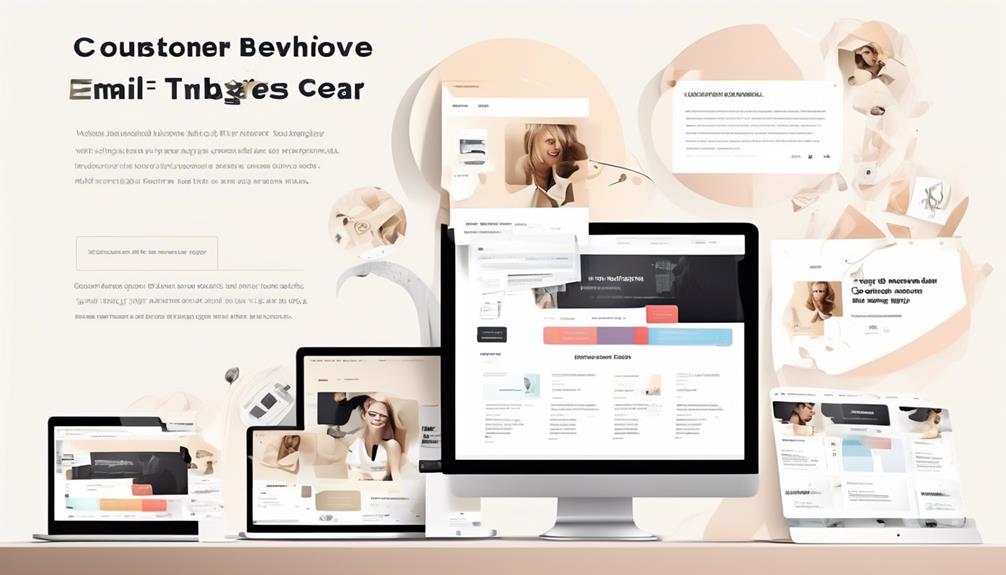Personalized Email Strategies
Google Analytics for Email Marketing
Only Google Analytics can reveal the hidden potential of your email marketing efforts – uncover the game-changing insights that await!

Our journey has evolved significantly from solely depending on intuition and random guesses to evaluate the effectiveness of our email marketing strategies. Given the growing significance of making decisions based on data, it’s critical to examine the ways in which Google Analytics can transform our method of comprehending the influence of email campaigns.
But what exactly can Google Analytics unveil about the effectiveness of our email marketing strategies? Let’s uncover the powerful insights it can provide and how it can shape the future of our email marketing endeavors.
Key Takeaways
- Tracking email campaigns using Google Analytics provides valuable insights into email marketing performance
- Integrating Google Analytics with email campaigns allows for tracking metrics such as click-through rates, conversions, and bounce rates
- By analyzing data, marketers can understand subscriber preferences, subject line performance, and determine the optimal sending time for email campaigns
- Google Analytics enables data-driven decision-making by comparing different campaigns, specific emails, and marketing channels, leading to informed strategies for enhancing email marketing efforts.
Importance of Tracking Email Campaigns
Tracking email opens and user behavior is essential for gaining valuable insights into the performance and optimization of email marketing campaigns. By utilizing Google Analytics, we can track crucial metrics such as click-through rates, link clicks, real-time conversions, and bounce rates.
This data allows us to understand subscriber preferences, measure subject line performance, and determine the optimal sending time for our email campaigns. Integrating Google Analytics into our tracking efforts involves creating an account, basic javascript and HTML coding, and formatting our email campaign links to enable tracking.
The ability to organize data based on email subject fields and campaign dates provides us with meaningful long-term statistics and more organized email marketing reports over time. Furthermore, analyzing email campaign reports in Google Analytics empowers us to compare different campaigns, specific emails, and other marketing channels, leading to informed decisions and optimized strategies.
The importance of tracking email opens and user behavior can’t be overstated as it forms the foundation for making data-driven decisions to enhance our email marketing efforts.
Leveraging Google Analytics for Tracking

After understanding the importance of tracking email campaigns, we can now explore how to effectively leverage Google Analytics for comprehensive tracking and analysis of email marketing performance.
Leveraging Google Analytics for email tracking involves several key steps:
- Integrate Google Analytics with Email Campaigns:
Integrate Google Analytics with your email campaigns by adding UTM parameters to the links within your emails. This will enable tracking of specific campaign data in your Google Analytics account.
- Track Email Campaigns in Google Analytics:
Once the integration is complete, monitor the performance of your email campaigns in Google Analytics. Track traffic, link clicks, conversions, and bounce rates to gain insights into user behavior and campaign effectiveness.
- Organize Data Using Campaign Name and Date:
Organize your email campaign data by using specific campaign names and dates. This will facilitate easy tracking and analysis of email performance over time.
Setting up Google Analytics for Email Tracking
To effectively set up Google Analytics for email tracking, we can optimize our email campaign links by incorporating UTM parameters to enable precise tracking of campaign data within Google Analytics. By utilizing Google’s URL builder, we can create trackable URLs that contain UTM parameters such as source, medium, campaign, and content. This allows us to attribute specific campaign data to our email marketing efforts accurately.
Additionally, setting up Google Analytics to track email involves creating advanced segments to isolate email traffic and analyze user behavior. This segmentation enables us to gain insights into the effectiveness of our email marketing campaigns within Google Analytics.
Furthermore, to track email engagement accurately, it’s essential to tag all links within the email with UTM parameters. This ensures that all clicks from the email are captured and attributed correctly within Google Analytics.
Analyzing Email Campaign Data

Analyzing email campaign data in Google Analytics provides valuable insights into user behavior, engagement, and the effectiveness of our email marketing efforts. Utilizing Google Analytics for email tracking allows us to delve into the following essential aspects of our email campaigns:
- Email Opens and Click-Through Rates: By tracking email opens and link clicks, we gain a comprehensive understanding of user engagement and the effectiveness of our email content.
- Campaign Tracking with UTM Parameters: Integrating UTM parameters into our email links enables us to categorize and analyze campaign data effectively, allowing for precise measurement of campaign performance.
- Advanced Segmentation and Goal Tracking: Leveraging Google Analytics’ Advanced Segments feature and setting up specific goals enables us to analyze the performance of different email campaigns, segment data by various criteria, and gain valuable insights for optimizing future campaigns.
Advanced Segmentation for Email Tracking
Advanced Segmentation in email tracking allows marketers to categorize recipients based on specific behaviors or attributes, providing valuable insights into the effectiveness of different email campaigns for targeted audience segments.
Through the use of Google Analytics and Advanced Segments, email marketers can analyze and compare performance metrics across various segments, enabling a deeper understanding of user engagement and conversion rates.
This level of audience segmentation goes beyond basic tracking and allows for a more granular examination of email campaign effectiveness.
By utilizing Advanced Segmentation, email marketers can assess the impact of different traffic sources, demographics, and user behaviors on email engagement, leading to more informed decision-making in campaign optimization.
Additionally, the ability to conduct A/B testing within specific segments provides valuable insights into the most effective email content and strategies for different audience groups.
Link tracking within these segments further enhances the understanding of user interaction with email content, ultimately contributing to more personalized and targeted email marketing efforts.
Frequently Asked Questions
Can Google Analytics Track Email Marketing?
Yes, Google Analytics can track email marketing performance by integrating with your website. It provides valuable insights, such as user behavior, click-through rates, conversions, and bounce rates.
However, for email-specific metrics like open rates and frequency, additional tools or ESP analytics are necessary.
This integration allows us to optimize email marketing strategies by understanding subscriber preferences, subject line performance, and optimal sending times.
How Do I Set up Google Analytics for Email?
We start by integrating Google Analytics with your website and utilize UTM parameters to track campaign URLs.
Organizing data with naming conventions based on email subject fields and campaign dates is crucial for meaningful statistics over time.
After sending a campaign with Google Analytics tracking, we access our account to view the report for the tracked website and analyze trends and changes over time.
This allows us to make informed decisions and evaluate the effectiveness of our marketing strategies.
Can I Use Google for Email Marketing?
Yes, we can use Google for email marketing.
By integrating Google Analytics with our email campaigns, we gain valuable insights into user behavior and engagement.
This allows us to track open rates, click-through rates, and user activity on our website after interacting with our emails.
With this data, we can optimize our email marketing strategies, measure ROI, and make informed decisions for continuous improvement and higher conversions.
How to Check Email Marketing Campaign Performance on Google Analytics?
We can check email marketing campaign performance on Google Analytics by analyzing key metrics such as open rates, click-through rates, and conversions. This provides valuable insights into the effectiveness of our campaigns and helps us identify areas for improvement.
Conclusion
In conclusion, Google Analytics for email marketing is the compass that guides our campaigns, helping us navigate through the sea of data to reach our destination of success.
By analyzing metrics and leveraging advanced segmentation, we uncover hidden treasures of insights that shape our strategies.
With Google Analytics as our trusted ally, we set sail towards a horizon of optimized email marketing, propelled by the winds of data-driven decision-making.
Natali – Editor in Chief (Strategy and Mastery, AI Expert) Natali, our Editor in Chief, is the driving force behind our content’s strategic direction. With a keen eye for detail and a deep understanding of market trends, Natali ensures that our content is top-notch and strategically aligned with our client’s goals. Her expertise in AI helps to seamlessly integrate advanced technology into our marketing strategies, pushing the boundaries of conventional marketing.
Personalized Email Strategies
Email Marketing for Ecommerce Forum
Strategize your way to ecommerce success with powerful email marketing tactics – find out how to maximize impact and drive growth.

We’re all aware that in our modern, rapidly evolving digital landscape, it’s essential for any ecommerce venture to stay at the forefront.
One aspect that often gets overlooked is the power of email marketing. It's not just about sending out bulk emails anymore; it's about crafting strategic, targeted campaigns that truly resonate with your audience.
But how do you navigate the ever-changing landscape of email marketing to achieve maximum impact?
Well, that's what we're here to explore. Join us as we uncover the key strategies and best practices for leveraging email marketing to drive growth and success in the ecommerce space.
Key Takeaways
- Email marketing is a vital tool for driving sales and fostering customer loyalty in ecommerce.
- Targeting the right audience through data analysis and segmentation is crucial for successful email marketing campaigns.
- Crafting compelling email content with attention-grabbing subject lines and clear call-to-actions is essential for maximizing conversions.
- Leveraging analytics allows for optimization of email campaigns by identifying areas for improvement and tailoring content for maximum impact.
Importance of Email Marketing for Ecommerce
Email marketing plays a crucial role in driving sales and fostering customer loyalty in the competitive landscape of ecommerce. For online businesses, email marketing serves as a direct communication channel with customers, facilitating personalized interactions and targeted messaging.
By utilizing email templates and optimizing landing pages, ecommerce email campaigns can effectively build an email list, crucial for sustained engagement and conversions. The conversion rate for email marketing tends to be higher compared to other marketing channels, making it an indispensable tool for e-commerce owners.
Additionally, email marketing complements social media and affiliate marketing strategies, providing a holistic approach to reaching and engaging customers. This data-driven approach allows for precise targeting of specific customer segments, thus maximizing the impact of marketing efforts.
In essence, email marketing isn't just an option but a necessity for any online business seeking to thrive in the current market. Its performance-based nature and ability to foster customer loyalty make it an invaluable asset in the arsenal of ecommerce strategies.
Targeting the Right Audience

To effectively drive sales and foster customer loyalty in ecommerce, it's crucial to target the right audience through precise demographic and behavioral insights. Targeting the right audience is essential for successful email marketing campaigns and overall internet marketing strategies.
Here are four key tactics to ensure you're reaching the most receptive audience for your products or services:
- Identify Your Ideal Customer: Gather data on demographics, interests, and behaviors to understand who your ideal customer is and what motivates their purchasing decisions.
- Utilize Data Analytics for Segmentation: Use advanced analytics to segment and target your audience based on their preferences, past interactions, and online behavior.
- Tailor Messaging and Content: Craft personalized messages and content that resonate with the specific needs and pain points of your target audience, increasing the likelihood of engagement and conversion.
- Continuously Refine Targeting Strategies: Regularly analyze and refine your targeting strategies to ensure they remain effective and aligned with the evolving preferences of your audience.
Crafting Compelling Email Content
Crafting compelling email content involves leveraging the insights gained from targeting the right audience to create personalized and engaging messages that drive conversions and foster customer loyalty.
To enhance email open rates and engagement, attention-grabbing subject lines are essential.
Incorporating clear, compelling call-to-actions within the email content is crucial for driving conversions and sales.
Personalization and segmentation are key to delivering targeted and relevant messages to the audience, leading to a more personalized experience.
Furthermore, implementing automation can streamline and optimize email workflows, including cart abandonment and re-engagement campaigns. This not only saves time but also ensures that the right message reaches the right person at the right time.
Regularly testing and analyzing email campaigns is vital to identify areas for improvement and optimize performance.
Maximizing Conversions With Email Campaigns

Maximizing conversions with email campaigns requires strategic utilization of compelling subject lines and engaging content to improve open rates and drive conversions in e-commerce.
To achieve this, we need to leverage automation and personalization to create targeted and effective email marketing campaigns.
Implement best practices for e-commerce email design, including responsive layouts, eye-catching visuals, and clear call-to-actions.
Employ strategies such as segmenting email lists, offering incentives, and optimizing landing pages to rapidly grow your email list and reach a wider audience.
Emphasize the importance of follow-up emails in nurturing leads, driving conversions, and building strong customer relationships in e-commerce.
By personalizing content and creating an engaging experience for the recipients, we can significantly increase the likelihood of conversions.
Additionally, utilizing cookies to track user behavior and preferences can help tailor email campaigns to individual interests, further maximizing conversions.
It's crucial to continually analyze and optimize email campaigns based on data and insights to ensure maximum effectiveness in driving e-commerce conversions.
Leveraging Analytics for Email Optimization
After strategically implementing compelling subject lines and engaging content to improve open rates and drive conversions in e-commerce, it is crucial to leverage analytics for email optimization. By harnessing the power of data analytics, e-commerce businesses can gain valuable insights into the performance of their email marketing campaigns and make informed decisions to enhance their impact. The table below illustrates key metrics and strategies for leveraging analytics in email optimization:
| Metrics | Strategies | Benefits |
|---|---|---|
| Open rates | A/B testing subject lines | Improved engagement and open rates |
| Click-through rates | Analyzing subscriber behavior | Tailoring content for maximum impact |
| Conversion rates | Segmenting audience | Targeted campaigns for higher conversion rates |
Utilizing analytics enables marketers to understand subscriber preferences, refine their content strategy, and measure the impact of email marketing on overall business goals. By leveraging data-driven insights, e-commerce businesses can enhance the effectiveness of their email campaigns and deliver a more personalized and engaging experience for their subscribers.
How Can ChatGPT Prompts Enhance Email Marketing for Ecommerce?
Looking to ramp up your ecommerce email marketing strategy? Utilize ChatGPT email marketing prompts to craft engaging and personalized email content. These prompts can help create compelling subject lines, persuasive product descriptions, and targeted CTAs to drive higher conversion rates and customer engagement. Start using ChatGPT prompts today to elevate your email marketing game.
Frequently Asked Questions
How to Do Email Marketing for Ecommerce?
We segment our email list based on demographics, purchase history, and engagement to target marketing effectively.
We utilize automation to create personalized email workflows for different customer journey stages.
Compelling subject lines and clear call-to-actions improve open rates and encourage conversions.
Our e-commerce email design incorporates best practices like responsive layouts and engaging content.
Regular analysis and optimization of email campaigns improve performance and achieve higher ROI.
Is Email Marketing Effective for Ecommerce?
Absolutely, email marketing is incredibly effective for ecommerce. It allows us to directly reach and engage with our customer base, driving sales and fostering loyalty. With the right strategies in place, such as personalization and segmentation, we can see significant returns on our email marketing efforts.
Additionally, videos can be a powerful tool for capturing attention and boosting conversion rates. When done right, email marketing is a game-changer for ecommerce businesses.
What Is the Best Email Sequence for Ecommerce?
The best email sequence for ecommerce involves a strategic combination of a personalized welcome email, tailored product recommendations, and compelling promotional offers.
We also implement automated triggers for abandoned carts and post-purchase feedback to maximize engagement.
Our dynamic content showcases product features and customer testimonials, driving higher conversion rates.
Additionally, we ensure timely order confirmation, shipping updates, and delivery notifications to keep customers informed and satisfied throughout their purchase journey.
How Can E Commerce Businesses Get Prospects and Customers to Open Their Emails?
To get prospects and customers to open emails, we craft attention-grabbing subject lines and personalize content based on behavior and preferences. Compelling visuals and automation for email workflows enhance engagement. Regular testing and analysis optimize performance.
These strategies drive higher open rates and customer engagement, crucial for e-commerce success. We've seen significant improvements in email open rates and customer interactions through these methods, making them essential for any e-commerce business.
Conclusion
In conclusion, email marketing is an essential tool for ecommerce success.
Did you know that 80% of retail professionals say that email marketing is their greatest driver of customer retention?
With personalized communication, targeted content, and analytics-driven optimization, email campaigns have the power to significantly impact business growth and customer satisfaction.
It's clear that investing in email marketing is a strategic move for any ecommerce forum.
Erik – Email, SEO, AI Expert Writer Erik is the strategist, the thinker, and the visionary. His role at Influenctor is pivotal in integrating SEO with AI-driven content strategies. With an extensive background in email marketing and a profound understanding of search engine algorithms, Erik develops innovative strategies that elevate our client’s online presence. His work ensures that our content is seen, felt, and remembered.
Personalized Email Strategies
4 Best Tips for Personalizing Emails to Engage More
Not sure how to make your emails stand out?

You might know the sensation of getting an email that feels like it’s tailored specifically to you. Perhaps it used your name or brought up something you’ve recently taken an interest in. Such personal touches can greatly influence engagement and the likelihood of a response.
But how can you consistently achieve that level of personalization in your own email marketing efforts? Well, there are four key strategies that can help you elevate your email personalization game and truly connect with your audience on a deeper level.
These tips can make a real difference in how your emails are received and acted upon, so let’s explore them together.
Key Takeaways
- Actively gather customer data through email sign-up forms and surveys to understand preferences and target personalized subject lines.
- Tailor emails to each customer based on previous email data, optimizing timing and delivery for better engagement.
- Personalize subject lines with recipient’s name, interests, or recent interactions to create a more engaging experience.
- Utilize dynamic content to personalize and tailor emails to individual preferences, increasing click-through rates and driving better results.
Collecting Relevant Customer Data
To personalize emails effectively, start by actively gathering relevant customer data through email sign-up forms and surveys to gain valuable insights and preferences from your subscribers. By implementing email sign-up forms on your website and utilizing surveys, you can gather essential customer data that will inform your email personalization techniques. Analyzing this data will help you understand your customers’ preferences, allowing you to target personalized subject lines and create dynamic content that resonates with them. With the right marketing software, you can utilize this customer data to send personalized messages that are both relevant and engaging.
Understanding your customers’ preferences through data collection allows you to tailor your emails to each customer, increasing the likelihood of customer interacting with your content. By analyzing previous email data, you can optimize email timing and delivery, ensuring that your messages reach your subscribers at the most impactful moments. Through targeted personalization, you can address recipients by their names, making your emails more personalized and increasing the chances of meaningful engagement.
Crafting Personalized Subject Lines

Crafting personalized subject lines begins with understanding your recipients’ individual preferences and needs to drive better engagement and open rates.
To create compelling subject lines, consider the following:
- Personalize with recipient’s name, interests, or recent interactions to increase open rates.
- Tailor subject lines to appeal to individual preferences and needs for better engagement.
- Utilize dynamic (smart) content to personalize based on recipient behavior for increased relevance.
- Use the recipient’s name in subject lines to create a more engaging experience and drive action.
Utilizing Dynamic Content
When it comes to engaging your recipients and driving better open rates, utilizing dynamic content in your emails offers a powerful way to personalize and tailor your message to individual preferences and behaviors. By leveraging dynamic content, you can create highly personalized and relevant email campaigns that cater to the specific needs and interests of your customers. This level of personalization can lead to increased customer engagement and click-through rates, ultimately driving better results for your email marketing efforts.
Benefits of Dynamic Content in Email Marketing Personalization Engagement Relevant Segmentation Tailoring emails to individual preferences and behaviors. Creating a more engaging experience for recipients. Providing targeted content based on segmentation. Increased Click-Through Rates Tailored Offers Individualized Messages Driving better results for email marketing campaigns. Delivering personalized product recommendations. Customizing messages to resonate with recipients.
Implementing Behavior-Triggered Emails

Looking to increase engagement and drive better email marketing results? Implement behavior-triggered emails to respond in real-time to customer actions and streamline communication. Here are some strategies to help you effectively implement behavior-triggered emails:
- Segmentation: Divide your customer base into specific groups based on their behavior, preferences, or actions to send relevant content.
- Personalization: Use subscriber tags and personalized product recommendations to create tailored emails that speak directly to your customers’ interests.
- Real-Time Response: Set up triggers to automatically send emails based on specific actions, such as abandoned carts or website visits, to engage customers at the right moment.
- Continuous Testing: Use integrated platforms and continuous testing to optimize personalized email campaigns for better results.
How Can Email Personalization Help Improve Customer Retention?
Email personalization strategies for retention can help improve customer loyalty by creating customized, relevant content that resonates with the recipient. By addressing the customer by name and tailoring the message to their preferences and behaviors, businesses can enhance the customer experience and increase the likelihood of repeat purchases.
Frequently Asked Questions
Are Personalized Emails More Effective?
Personalized emails are significantly more effective. They boost open rates by 29% and conversion rates by 41%.
When you use the recipient’s name, tailor content to their interests, and segment your audience, you create a more engaging experience.
Implementing concise sales funnels and automated campaigns further enhances the personal touch.
How Email Personalization Can Help You Stand Out?
Want to stand out in a crowded inbox? Personalized emails are your secret weapon. By tailoring content to fit recipients’ interests, using their name, and segmenting your audience for targeted messages, you’ll grab attention and drive engagement.
Implementing automation and analyzing data for relevance will further enhance your impact. Don’t miss out on this powerful tool to connect with your audience on a deeper level and boost your email marketing success.
Does Personalization Increase Open Rates?
Yes, personalization does increase open rates. By addressing recipients with their names and tailoring content to their interests, you create a more engaging and relevant experience.
Segmenting your market allows for targeted messaging, further boosting open rates. Incorporating concise sales funnels and utilizing automated campaigns with a personal touch also contribute to higher engagement.
Data shows that personalization significantly improves open rates, making it a crucial strategy for email marketing success.
How Do I Make My Mass Email More Personal?
To make your mass email more personal, start by addressing the recipient by name and tailoring the content to match their interests.
Using segmentation and automation, you can deliver targeted messages that resonate with specific groups.
Incorporating customer data allows for accurate personalization.
Remember, ‘a little goes a long way’ – even small customizations can make a big impact on engagement.
Keep it personal, relevant, and watch your engagement soar.
Can I Use Personalization Tips in Mailchimp Templates to Increase Engagement?
Yes, you can use personalization tips in Mailchimp templates to increase engagement. A create Mailchimp templates tutorial can guide you on how to personalize your email content with recipient’s name, location, or past interactions. This can lead to higher engagement and better conversion rates for your email campaigns.
How Can Email Warm-Up Tools Help with Personalizing Emails for Better Engagement?
When it comes to personalizing emails for better engagement, using top email warmup tools can make a significant difference. These tools can help in improving deliverability, building sender reputation, and increasing email open rates. With the help of top email warmup tools, businesses can establish trust and build relationships with their audience.
Conclusion
You’ve learned the art of personalizing emails to engage your audience.
By collecting relevant customer data, crafting personalized subject lines, utilizing dynamic content, and implementing behavior-triggered emails, you’ve created a symphony of personalized communication that resonates with your audience.
Your emails are like personalized gifts, tailored to fit each recipient like a glove, drawing them in and guiding them towards the desired action.
Keep up the personalized approach and watch your engagement soar.
Erik – Email, SEO, AI Expert Writer Erik is the strategist, the thinker, and the visionary. His role at Influenctor is pivotal in integrating SEO with AI-driven content strategies. With an extensive background in email marketing and a profound understanding of search engine algorithms, Erik develops innovative strategies that elevate our client’s online presence. His work ensures that our content is seen, felt, and remembered.
Personalized Email Strategies
Best Email Marketing Platform for Ecommerce
Pondering which email marketing platform is best for your ecommerce business? Stay tuned to uncover the essential factors to consider.

Alright, everyone, let’s discuss email marketing platforms for ecommerce.
In today's digital age, finding the right platform can be like searching for a needle in a haystack. With so many options and features to consider, it's easy to feel overwhelmed. But fear not, we've done the research and are here to shed some light on the subject.
Stick around to discover the key factors to consider when choosing the perfect platform for your ecommerce business.
Key Takeaways
- Integration with popular ecommerce platforms like Shopify is an important factor to consider when choosing an email marketing platform for ecommerce.
- Customizable email templates that cater to different campaign needs are essential for effective email marketing.
- Automation capabilities, including advanced features for targeted messaging and abandoned cart scenarios, are crucial for efficient and personalized communication.
- Customer behavior tracking, robust segmentation capabilities, and industry benchmark data are important for measuring the effectiveness of email marketing campaigns.
Top Ecommerce Email Marketing Platforms
When evaluating the top ecommerce email marketing platforms, it's crucial to consider their online store integration, email templates, contact segmentation, and automation capabilities to ensure effective communication with customers.
Among the top contenders, Omnisend stands out with its seamless integration with popular ecommerce platforms like Shopify, making it easier to sync customer data and behavior. The platform offers a variety of customizable email templates to suit different campaign needs, ensuring a visually appealing and consistent brand experience. Additionally, its advanced automation features enable targeted messaging, such as personalized product recommendations based on customer behavior.
Klaviyo, another top player, excels in SMS marketing integration, allowing businesses to reach customers through multiple channels. Its robust customer segmentation capabilities enable precise targeting, ensuring that the right message reaches the right audience. Klaviyo's automation features are particularly effective for addressing abandoned cart scenarios, recovering potentially lost sales through timely and personalized email campaigns.
These platforms, along with others like ActiveCampaign, GetResponse, and MailerLite, offer unique strengths in ecommerce email marketing, catering to the diverse needs of businesses while providing the essential tools for effective customer engagement and conversion-focused campaigns.
Key Features and Pricing

Omnisend offers automatic branding of emails and popups, with paid plans starting at $16/month and a free plan available, making it an attractive option for businesses seeking cost-effective yet feature-rich email marketing solutions.
This platform is ideal for ecommerce stores looking to leverage marketing automation features, such as sending targeted messages based on customer behavior. Additionally, Omnisend's pricing model scales with the number of contacts, ensuring that growing businesses can seamlessly manage their email marketing efforts without breaking the bank.
Furthermore, the ability to send abandoned cart emails is crucial for ecommerce marketing, and Omnisend excels in this area, helping businesses recover potentially lost sales by re-engaging with customers who've left items in their online shopping carts.
With a focus on ecommerce features and a pricing structure designed to accommodate businesses of all sizes, Omnisend stands out as a compelling option for those seeking an email marketing platform that caters specifically to the needs of online retailers.
Omnisend
Omnisend's comprehensive email marketing platform, tailored specifically to the needs of ecommerce businesses, offers a range of powerful features and a flexible pricing model to help businesses effectively engage with their customers and drive sales.
With Omnisend, you can enhance customer experience, increase engagement with visually appealing emails, and create professional-looking emails with a user-friendly email editor. The platform also allows you to flexibly segment contacts based on parameters like geography and age group, and automate common ecommerce marketing scenarios.
Omnisend provides CRM features to get a bird's eye view of customers, store individual profiles, understand customer behavior, and optimize marketing efforts with advanced insights from HubSpot CRM. Additionally, it boasts a good email deliverability score, ensuring emails reach recipients' inboxes to improve email campaign effectiveness.
With the ability to address customers personally in emails and measure revenue contributed by emails through detailed sales reports, Omnisend stands out as a top choice for ecommerce businesses in need of advanced email marketing capabilities.
Klaviyo

Klaviyo revolutionizes email marketing for ecommerce businesses with its extensive range of customizable templates, automated flow options, and advanced segmentation features.
The platform offers over 100 customizable email templates, ensuring visually appealing and personalized communication with your audience.
Klaviyo's automated flow templates and send time optimization enable effective email campaigns, while its lead generation tools like web forms and landing pages help capture and nurture leads.
Additionally, Klaviyo provides industry email benchmark data, allowing you to measure the effectiveness of your email marketing efforts.
Its advanced segmentation and personalization options empower you to engage with your audience in a highly tailored manner, driving better results for your ecommerce business.
With features like abandoned cart reminders triggered by store purchases, Klaviyo stands out as one of the best email marketing software for ecommerce.
Its robust capabilities, coupled with excellent customer support, make it a top choice for businesses looking to excel in ecommerce email marketing.
ActiveCampaign
Revolutionizing email marketing for ecommerce businesses, ActiveCampaign offers sophisticated CRM and sales automation capabilities that empower users to engage customers effectively based on their behavior. With ActiveCampaign, ecommerce business owners can harness the power of marketing automations and smart segmentation to deliver targeted and personalized content to their audience.
The platform also provides email split testing, enabling users to optimize their email content and design for better results. Additionally, ActiveCampaign features site tracking and event tracking, allowing ecommerce brands to gain valuable insights into customer behavior and preferences, thus enabling them to tailor their marketing strategies accordingly.
ActiveCampaign stands out as one of the best email marketing platforms for ecommerce due to its comprehensive set of features, including SMS marketing capabilities, which make it a versatile digital marketing platform for ecommerce stores.
Is the Best Email Marketing Platform for Woocommerce also Suitable for Ecommerce in General?
The best email marketing platform for WooCommerce may also be suitable for ecommerce in general. With its tailored features and integration capabilities, it can effectively target and engage customers, drive sales and boost overall conversion rates. It offers the flexibility and scalability needed for any ecommerce business.
Frequently Asked Questions
What Is the Best Email Marketing Platform for Ecommerce?
We've researched the best email marketing platforms for ecommerce and found that Omnisend, Klaviyo, ActiveCampaign, GetResponse, and MailerLite are top contenders.
When selecting a platform, it's crucial to consider features like online store integration, email templates, contact segmentation, and email automation. These platforms should offer direct integration, customizable email templates, and a user-friendly editor.
It's important to prioritize platforms that enhance customer experience and engagement.
Is Email Marketing Good for Ecommerce?
Absolutely, email marketing is exceptional for ecommerce! It's an essential tool for engaging customers, driving sales, and building lasting relationships.
Our experience shows that targeted email campaigns yield impressive results, boosting conversion rates and customer lifetime value. By leveraging data-driven insights and personalized content, we optimize every aspect of our email marketing strategy.
It's a powerful and cost-effective method to maximize customer engagement and revenue.
How to Do Email Marketing for Ecommerce?
We do email marketing for ecommerce by leveraging contact segmentation and email automation to send targeted and personalized emails. This approach increases sales and improves customer satisfaction and engagement.
We also ensure that our email marketing platform seamlessly integrates with our ecommerce store, offers a wide selection of customizable templates, and provides user-friendly email editing capabilities to save time and effort.
Additionally, we evaluate platforms based on sales reporting, customer relationship management, email deliverability, and pricing plans.
What Is the Best Email Sequence for Ecommerce?
What is the best email sequence for ecommerce?
We craft personalized post-purchase follow-ups, winback emails, and cart abandonment solutions to drive conversions and boost customer engagement.
Our strategy focuses on personalization, leveraging customer data to recommend products and recover abandoned carts.
Sales reporting guides our optimization efforts, ensuring the highest effectiveness.
We prioritize email deliverability, using platforms like MailerLite and ActiveCampaign, and consider affordability, ease of use, automation, segmentation, and integrations when selecting our email marketing software.
Conclusion
After comparing the top email marketing platforms for ecommerce, we've found the perfect fit for our business.
The features and pricing of Omnisend have us excited to take our email marketing to the next level.
With its advanced segmentation, automation, and reporting capabilities, we're confident that Omnisend will help us drive more sales and build stronger customer relationships.
We can't wait to see the impact it will have on our ecommerce business.
Natali – Editor in Chief (Strategy and Mastery, AI Expert) Natali, our Editor in Chief, is the driving force behind our content’s strategic direction. With a keen eye for detail and a deep understanding of market trends, Natali ensures that our content is top-notch and strategically aligned with our client’s goals. Her expertise in AI helps to seamlessly integrate advanced technology into our marketing strategies, pushing the boundaries of conventional marketing.
-

 Email Automation2 weeks ago
Email Automation2 weeks agoAutomated Email Marketing 101: A Beginner's Tutorial
-

 Email Warmup3 weeks ago
Email Warmup3 weeks agoWarm Follow-Up Email
-

 Email Design Hub1 month ago
Email Design Hub1 month ago3 Essential Tools for Email Marketing Design Success
-

 Email Marketing2 weeks ago
Email Marketing2 weeks agoWhat Is Email Marketing Advantages and Disadvantages
-

 Email Marketing2 weeks ago
Email Marketing2 weeks agoWhy Email Marketing Is Effective
-

 Email Template2 weeks ago
Email Template2 weeks agoCrafting the Perfect Book Club Invitation Email Template
-

 Email Marketing2 weeks ago
Email Marketing2 weeks agoDoes Email Marketing Work in 2024
-

 Search Engine Optimization2 weeks ago
Search Engine Optimization2 weeks agoSEO Checklist: Enhance Your Site’s Performance

















